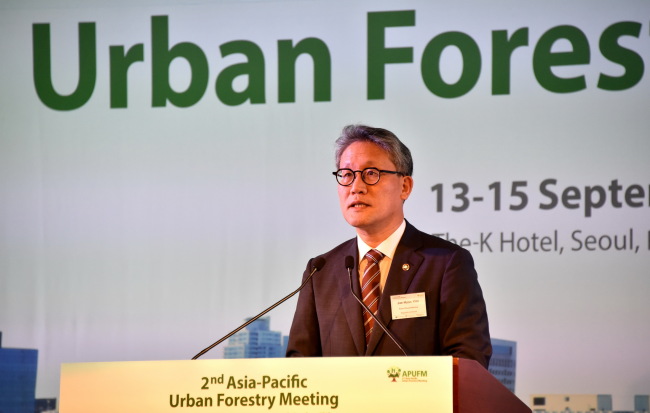The Asia-Pacific region is home to more than 4 billion people, or roughly 60 percent of the entire world population, and 17 megacities. Although these economic hubs have helped lift millions of people out of poverty, the current era of rapid urbanization is leading to the depletion of natural resources, diminishing water quality, increased air pollution and adverse climate change effects, according to a report by Asia-Pacific Urban Forestry Meeting.
Representatives from 17 countries gathered in Seoul from Sept. 13 to 15 for the second Asia-Pacific Urban Forestry Meeting in a global cooperative effort to find ways to make city living both safe and sustainable by expanding the number of urban forests.
 |
Kim Jae-hyun, minister of the Korea Forest Service, speaks at an opening ceremony of the second Asia-Pacific Urban Forestry Meeting held in Seoul on Sept. 13. (Korea Forest Service) |
Under the slogan, “Acting together for greener and cooler cities,” the meeting welcomed some 200 scholars and members of governmental and nongovernmental organizations looking to tackle environmental and socioeconomic issues caused by increasing pollution across the world’s largest metropolitan areas.
According to a report from the APUFM, the gathering led to the spawning of the “Seoul Action Plan” in an effort to expand awareness of the benefits that urban forests and trees, including green infrastructure, provide to communities throughout the Asia-Pacific Region.
The new Seoul Action Plan strives to achieve a total of seven city goals: greener, cleaner, cooler, healthier, wealthier, more cultured and increased biodiversity.
The main guiding principles of the plan are based on the Zhuhai declaration that was established during that first annual Asia-Pacific Urban Forestry Meeting held in Zhuhai, China last year. The declaration pledged to, “Raise awareness of the functions and benefits of urban forests and trees by enhancing advocacy, communication and public education, which in turn may increase urban forestry investment by diversifying funding resources.”
The forestry report also stated that sustainable governance of Asia-Pacific cities needs to be improved through proactive policies, strategic planning and developing a sound legislative framework and governance system for urban forest and trees.
“Urban and peri-urban forests and trees can provide a wide range of benefits to urban communities by improving environmental quality, enhancing food security, conserving urban biodiversity, mitigating climate change, stimulating green economy, preserving natural and cultural heritage, strengthening social cohesion and providing environmental education opportunities,” said the report.
Among its many long-term goals, the new Seoul Action Plan, with has an overall 10-year time frame, looks to increase the canopy cover of cities in the Asia-Pacific region by at least 10 percent by 2027 and to expand the accessibility of urban forest and green spaces for the purposes of human health and well-being to be available to at least 80 percent of citizens.
By Julie Jackson (
juliejackson@heraldcorp.com) and Lee Kwon-hyung (
kwonhl@heraldcorp.com)







![[Today’s K-pop] Blackpink’s Jennie, Lisa invited to Coachella as solo acts](http://res.heraldm.com/phpwas/restmb_idxmake.php?idx=644&simg=/content/image/2024/11/21/20241121050099_0.jpg)
